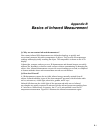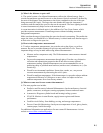
Ti20
Users Manual
B-2
0.1 A 1 A 1 UA 100 A
0.6 0.8 1 1.5 2 3 4 6 8 10 15 20 300.4
1 µ 10 µ 100 µ 0.1 cm 1 cm 10 cm 1 m 10 m 100 m 1 km 10 km 100 km
Wavelength
Visible
Wavelength µm
Gamma
Rays
X-Rays Ultraviolet Infrared
Infrared Measurement Region
Radio
EHF SHF UHF VHF HF MF LF VLF
0.1 µ
dag011f.eps
Figure B-1. Infrared Measurement Region
Q. How to assure accurate temperature measurement?
A. A solid understanding of infrared technology and its principles lies behind accurate
temperature measurement. When the temperature is measured by a non-contact device the
IR energy emitted from the measured object passes through the optical system of the
thermometer or thermal imager and is converted to an electrical signal at the detector.
This signal is then displayed as a temperature reading and/ or thermal image. There are
several important factors that determine accurate measurement. The most important
factors are emissivity, distance to spot ratio, and field- of-view.
Q. What is emissivity?
A. All objects reflect, transmit and emit energy. Only the emitted energy indicates the
temperature of the object. When IR thermometers or thermal imagers measure the surface
temperature they sense all three kinds of energy, therefore all thermometers have to be
adjusted to read emitted energy only. Measuring errors are often caused by IR energy
being reflected by light sources.
Some IR thermometers and thermal imagers allow you to change the emissivity in the
unit. The value of emissivity for various materials can be looked up in published
emissivity tables.
Other units have a fixed, pre-set emissivity of 0.95, which is the emissivity value for most
organic materials and painted or oxidized surfaces. If you are using a thermometer or
thermal imager with a fixed emissivity to measure the surface temperature of a shiny
object you can compensate by covering the surface to be measured with masking tape or
flat black paint. Allow time for the tape or paint to reach the same temperature as the
material underneath. Measure the temperature of the taped or painted surface. That is the
true temperature.


















